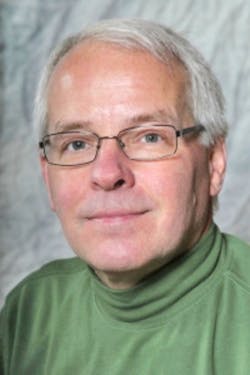Austin, TX. In a Tuesday morning NIWeek keynote address, Eric Starkloff, executive vice president for global sales and marketing, asked attendees to consider the systems required to get them to Austin. “Consider the effort to design, build, and test the airplane you took,” he said. “It’s a system of systems interconnected in real time and supported by GPS, radar, and air-traffic-control systems and probably even had Wi-Fi on board.” No single person invented that technology, and the effort involved was not even centrally coordinated. Nevertheless, he said, air travel is the safest and fastest method of travel ever invented.
In contrast, he described a computer printer as brittle—as soon as it becomes incompatible you probably simply replace it.
The natural world, too, is a system of systems, and it operates with the parallel world we created—the engineered world made of software, electronics, and networks, Starkloff said. The engineered world is a technology ecosystem powered by software and is constantly changing and adapting. The technology ecosystem takes a fundamentally different approach from that of a closed product like a printer, which can’t scale to meet the needs of a changing world. In contrast, he commented, a smartphone is a great product in and of itself, but the real value isn’t in the product but rather in the system of open software and cloud-based services.
The community attending NIWeek, Starkloff said, is at the leading edge of systems thinking. “With a software-based systems platform, you created new solutions to longstanding problems,” he said. NI’s initial role was to connect instruments through software and GPIB. “Our belief was that with an open platform, you as a community could create the best solutions, and we were right,” he said, adding that NI customers have created applications NI itself could never have imagined, ranging from measuring and preventing head trauma to building a cataract surgery machine. “We invested our time and passion and billions dollars to build an open platform that removes constraints,” he said.
Starkloff then turned his attention to inspiration and asked attendees to reflect on what prompted them to become scientists and engineers. He said he was inspired by the incredible advances in technology when he was a kid—the space shuttle and the Apple computer. (He must be a little younger than I am—for me it was Project Mercury.) “If we can do that, we can do anything,” he said. “I knew I wanted to be a part of it.”
But he suggested that inspiration can fade. Our imaginations can become closed because we only work on the problems right in front of us. “Somewhere along the way we traded flying cars for emojis,” he said, adding that we can find ourselves “…staring at phones, not stars.” Some focus on algorithmic trading or social media or online advertising—not getting to Mars or curing cancer. Technology can improve our lives, but it can also distract us, he said.
He closed by noting that each NIWeek attendee has a story—a new approach to an old challenge. He urged attendees to spend the week sharing their stories with others and to support each other as a community—inspiring each other to achieve more than could be achieved alone. “Inspire the next generation,” he said. “Together we can dream big and make those dreams real.”
About the Author

Rick Nelson
Contributing Editor
Rick is currently Contributing Technical Editor. He was Executive Editor for EE in 2011-2018. Previously he served on several publications, including EDN and Vision Systems Design, and has received awards for signed editorials from the American Society of Business Publication Editors. He began as a design engineer at General Electric and Litton Industries and earned a BSEE degree from Penn State.
